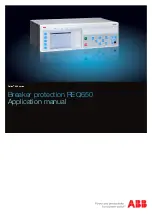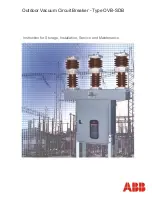
M ED I U M VO LTAG E P R O D U C T S
15
•
No external discharge may occur on the surfaces
of equipment at operating voltage. This can, for
example, be detected by characteristic noises, a
clearly perceptible smell of ozone, or visible
glowing in the dark.
•
If irregular conditions are detected, then
corresponding repair measures should be
initiated.
7.2.2 Magnetic actuator operating mechanism
(Figures 9/11 and 9/19)
A first functional test of the operating mechanism is
to be performed:
•
after the stated number of operating cycles, or
•
during maintenance work as described in section
7.2.1.
Before the functional test, open the circuit breaker
and
•
move it into the test position (withdrawable
breaker) or
•
isolate and secure the working area in accordance
with the Safety Regulations to DIN VDE / IEC (with
stationary mounted breakers).
•
Observe the procedure for capacitor discharge as
set down in section 7.1.
•
Perform visual examination of the condition
(removing front plate 1.1), e.g.:
- the lubrication at the rotary bearings,
- the operating cycle counter,
- the sensor mounting,
- the position indicator.
Scope of functional testing:
•
Connect the supply voltage.
•
Perform several switching operations under no
load. This is predominantly applicable to circuit
breakers which are rarely operated under normal
circumstances.
•
Perform one rapid OFF/ON/OFF operation with
the circuit breaker to check the storage capacitors
by pressing buttons 3 and 4 rapidly in sequence.
•
The LEDs on the inductive proximity switches 15
and 16 are activated when the circuit breaker has
reached its OFF and ON limit positions
respectively.
7.2.3 Withdrawable part
•
The inspection should always include a visual
examination of the withdrawable part assembly.
Special attention is to be paid to those parts
which may possibly be damaged by improper
handling.
•
Perform a visual check on the condition of the
isolating contact system. It is recommended that
the contact system be turned alternately so that
its inner contact points can be cleaned.
If there are signs of impermissible overheating
(discoloured surface), the contact points are to be
cleaned (see the section on repairs).
•
The interlock conditions and the ease of
movement of the withdrawable assembly are to be
checked as described under “Repair”.
•
When checking the interlock conditions, it is
essential to ensure that no force is used.
Maximum torque 25 Nm!
7.3 Servicing
7.3.1 Circuit breaker in general
If the necessity of cleaning is established during
inspections as described in 7.2.1, the following
procedure is to be adopted:
•
Prior to cleaning, isolate and secure the working
area if necessary in accordance with the safety
regulations of DIN VDE and IEC.
•
Observe the procedure for capacitor discharge as
set down in section 7.1.
•
Cleaning of surfaces in general:
- Remove weakly adhering dry dust deposits with
a soft dry cloth.
- Remove more strongly adhering dirt with a
slightly alkaline household cleanser, or with
Rivolta BWR 210.
•
Cleaning of insulating material surfaces and
conductive parts:
- Minor contamination: with Rivolta BWR 210.
- Strongly adhering contamination: with cold
cleanser 716.
After cleaning, wipe down with clean water and dry
carefully.
•
Observe the manufacturer’s instructions and the
special ABB instruction manuals BA 1002/E or BA
1006/E on safety at work.
Note:
Use only halogen-free cleaning agents. Never use
1.1.1-trichloroethane, trichloroethylene or carbon
tetrachloride!
7.3.2 Magnetic actuator operating mechanism
The magnetic actuator mechanism is maintenance-
free up to the number of operating cycles stated in
section 7.1.
Summary of Contents for VM1-T
Page 43: ...MEDIUM VOLTAGE PRODUCTS 43 ...










































